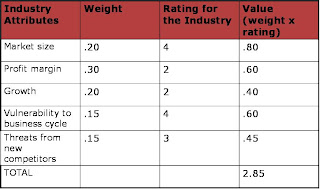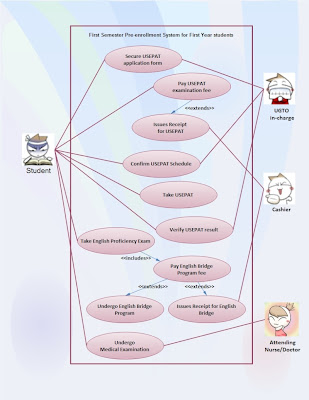Critical Success Factor Steps
MIS 2 - Assignment # 6
Identify and discuss the steps for "critical success factors" approach?
Any organization inherently possesses a mission which states why it exists and a vision which states where it is headed. In order to achieve the mission of an organization, all of the members of that particular organization should participate and contribute for the achievement of the goals and objectives of the organization as a whole. As our professor once said, every member should embrace the “one and only game plan” of the organization or else the organization will find it hard if not impossible to succeed. In addition, the organization must consistently concentrate on the key areas to achieve the mission. These key areas can be different from each organization depending on the type of organization and the type of industry that they are in. These key areas are what we call as the organization’s critical success factors.
Based on his study regarding CSFs, Rockhart provides a useful summary of similar but distinct definitions:
• key areas of activity in which favorable results are absolutely necessary to reach goals
• key areas where things must go right for the business to flourish
• “factors” that are “critical” to the “success” of the organization
• key areas of activities that should receive constant and careful attention from management
• a relatively small number of truly important matters on which a manager should focus attention
Based on the definitions stated above, I can comprehend that the CSF approach is a method used in order to identify the important elements or the “key areas” for the organization to achieve its mission.
According to Dr. John T. Drea, a professor of Marketing in Western Illinois University, here are the steps of the Critical Success Factors methods:
Step 1: Identify the relevant attributes for assessing industry attractiveness.
This is where the attributes that are relevant or necessary for the assessment of the industry where the organization belongs to is performed.
Some of the examples of relevant attributes that an organization can identify are: market size, profit margin, growth, vulnerability to business cycles and threats from new competitors/substitute products. In general, these are the factors which would determine the relative attractiveness of one industry compared to others.
Step 2: Assign weights for the importance of each attribute.
An example of this is the following (All weights should total to 1):
.20 Market size
.30 Profit margin
.20 Growth
.15 Vulnerability to business cycle
.15 Threats from new competitors/substitute products
These are the weights you would assign to each of the factors to determine the attractiveness of one industry compared to others.
Basically, this is the phase where you would weigh the level of importance of each attribute identified in step 1.
Step 3: Assign a rating (1-5) for each industry attribute, indicating the performance of the industry on the attribute (compared to others)
Step 4: Multiply the weight times the rating to get an overall industry value.
The step 3 and 4 covers the computation of the overall rating of each attribute of the organization in the industry.
Drea illustrated the step 3 and 4 with this figure as an example.

Step 5: Next, using the same factors and weights, evaluate the competitors along using a 1-5 scale
Step 6: Multiply the weight times the business attribute rating for each competitor.
Competitors in the same industry will be in a vertical line, but you can change weights to reflect different segments of an overall market.
The step 5 and 6 covers the computation of the attribute rating of each competitor in order to compare it with the organization being assessed. This comparison will enable the people concerned to evaluate the position of the organization based on the competitors in their corresponding industry.
To illustrate, here is an example:

Step 7: Plot the resulting point on a 2D grid
Step number 7 will provide a visual representation of the assessment of the critical factors of the organization for better understanding and comprehension.
Here is an example:

You can plot different competitors in different Industries on the same grid.
References:
Rockhart, John F. & Bullen, Christine V. A Primer on Critical Success Factors.
Cambridge, MA: Center for Information Systems Research, Massachusetts Institute of Technology, 1981.
Caralli, Richard A. (2004, July).The Critical Success Factor Method: Establishing a Foundation for Enterprise Security Management. Date Retrieved:
Drea, John T. Competitive Intelligence: Ideas for Analysis.Western Illinois University. Date Retrieved: December 27, 2009. Retrieved from:
Based on his study regarding CSFs, Rockhart provides a useful summary of similar but distinct definitions:
• key areas of activity in which favorable results are absolutely necessary to reach goals
• key areas where things must go right for the business to flourish
• “factors” that are “critical” to the “success” of the organization
• key areas of activities that should receive constant and careful attention from management
• a relatively small number of truly important matters on which a manager should focus attention
Based on the definitions stated above, I can comprehend that the CSF approach is a method used in order to identify the important elements or the “key areas” for the organization to achieve its mission.
According to Dr. John T. Drea, a professor of Marketing in Western Illinois University, here are the steps of the Critical Success Factors methods:
Step 1: Identify the relevant attributes for assessing industry attractiveness.
This is where the attributes that are relevant or necessary for the assessment of the industry where the organization belongs to is performed.
Some of the examples of relevant attributes that an organization can identify are: market size, profit margin, growth, vulnerability to business cycles and threats from new competitors/substitute products. In general, these are the factors which would determine the relative attractiveness of one industry compared to others.
Step 2: Assign weights for the importance of each attribute.
An example of this is the following (All weights should total to 1):
.20 Market size
.30 Profit margin
.20 Growth
.15 Vulnerability to business cycle
.15 Threats from new competitors/substitute products
These are the weights you would assign to each of the factors to determine the attractiveness of one industry compared to others.
Basically, this is the phase where you would weigh the level of importance of each attribute identified in step 1.
Step 3: Assign a rating (1-5) for each industry attribute, indicating the performance of the industry on the attribute (compared to others)
Step 4: Multiply the weight times the rating to get an overall industry value.
The step 3 and 4 covers the computation of the overall rating of each attribute of the organization in the industry.
Drea illustrated the step 3 and 4 with this figure as an example.

Step 5: Next, using the same factors and weights, evaluate the competitors along using a 1-5 scale
Step 6: Multiply the weight times the business attribute rating for each competitor.
Competitors in the same industry will be in a vertical line, but you can change weights to reflect different segments of an overall market.
The step 5 and 6 covers the computation of the attribute rating of each competitor in order to compare it with the organization being assessed. This comparison will enable the people concerned to evaluate the position of the organization based on the competitors in their corresponding industry.
To illustrate, here is an example:

Step 7: Plot the resulting point on a 2D grid
Step number 7 will provide a visual representation of the assessment of the critical factors of the organization for better understanding and comprehension.
Here is an example:

You can plot different competitors in different Industries on the same grid.
References:
Rockhart, John F. & Bullen, Christine V. A Primer on Critical Success Factors.
Cambridge, MA: Center for Information Systems Research, Massachusetts Institute of Technology, 1981.
Caralli, Richard A. (2004, July).The Critical Success Factor Method: Establishing a Foundation for Enterprise Security Management. Date Retrieved:
Drea, John T. Competitive Intelligence: Ideas for Analysis.Western Illinois University. Date Retrieved: December 27, 2009. Retrieved from:

Comments